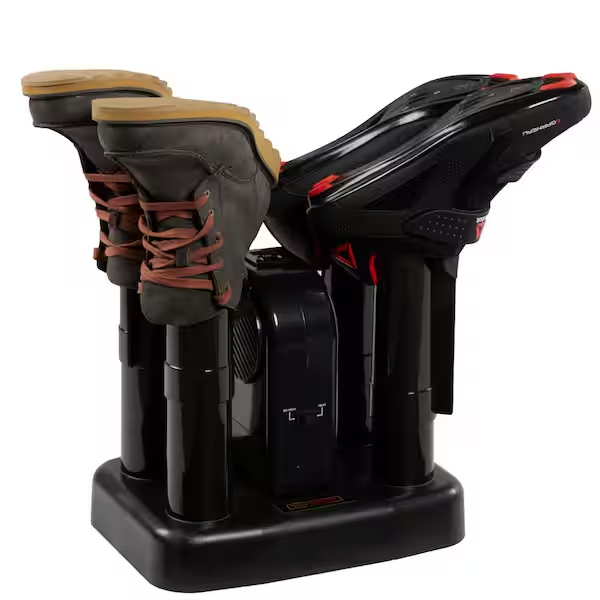Boot dryers have become essential tools for many outdoor enthusiasts, athletes, and busy professionals. Whether you’re hiking in the rain, working in wet conditions, or simply dealing with everyday moisture, a good boot dryer can significantly improve the longevity and comfort of your footwear. In this article, we’ll explore the different types of boot dryers, their features, and tips on how to choose the right option for drying your boots effectively.
Why You Need a Boot Dryer
Wet boots can cause discomfort and health problems. A boot dryer solves these issues efficiently. It ensures your footwear stays dry, hygienic, and ready to use.
Benefits of Using Boot Dryers
- Prevents Odor: Wet boots promote bacteria growth, causing bad smells. Dryers eliminate moisture and reduce bacteria.
- Extends Boot Life: Moisture weakens boot materials over time. Drying them keeps them durable and strong.
- Improves Comfort: Dry boots feel better to wear. This is especially important for outdoor activities.
- Health Benefits: Reduces the risk of skin infections caused by damp conditions.
Common Issues Caused by Wet Boots
- Mold and Mildew Growth: Wet boots create a perfect environment for mold, which can cause allergies.
- Unpleasant Smell: Persistent wetness leads to odor that is hard to remove.
- Material Damage: Long-term exposure to moisture degrades leather, fabric, and stitching.
- Cold and Discomfort: Wet footwear is uncomfortable, especially in cold weather.
Using a boot dryer can avoid these problems effectively. It is a worthwhile investment for everyone who uses boots regularly.
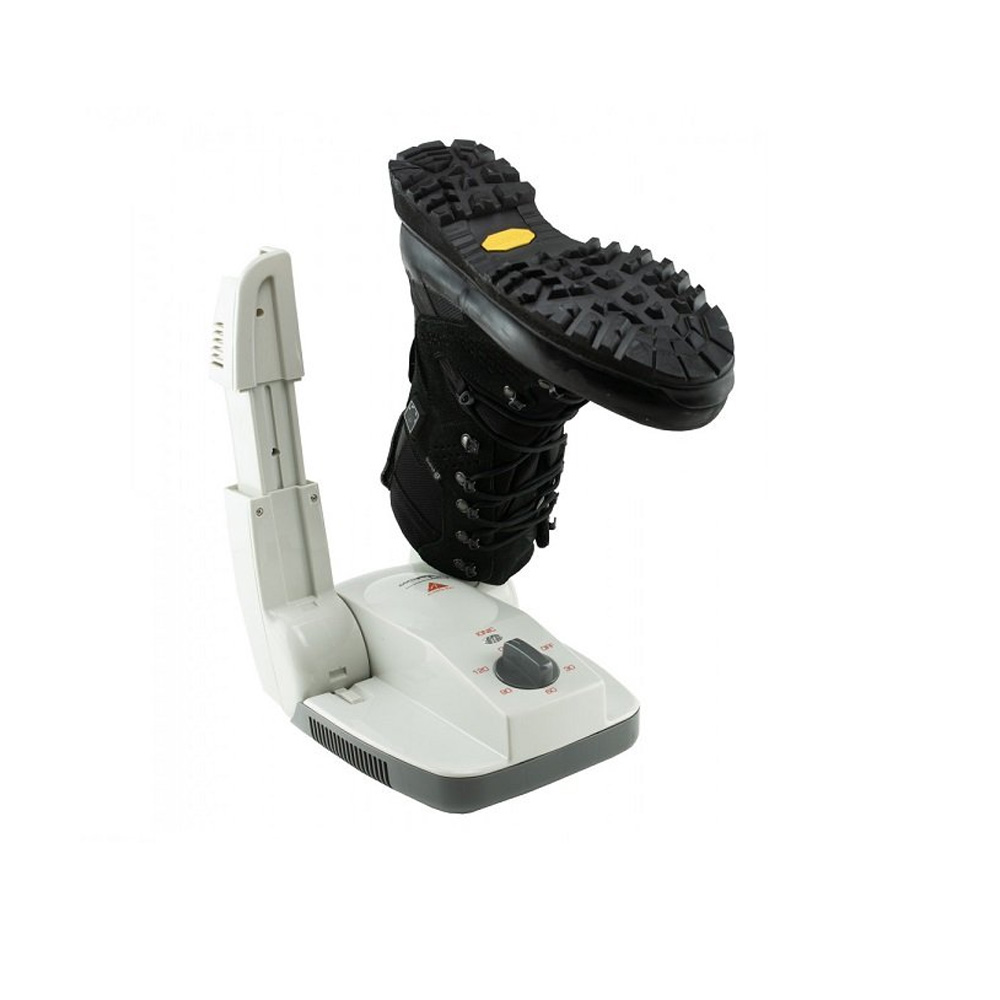
Types of Boot Dryers
There are several types of boot dryers available to suit different needs. Each type offers specific benefits, making it important to choose one based on your requirements and lifestyle. Below are the three main types of boot dryers you can consider.
Electric Boot Dryers
Electric boot dryers are the most common type. They use power to generate heat and airflow, effectively drying boots in a few hours. These dryers are ideal for wet boots that need fast drying.
Features:
- Efficient Drying: Uses warm air or heat to remove moisture quickly.
- Versatile: Suitable for all types of footwear, including leather and fabric.
- Different Models: Available in stationary and forced-air designs for tailored drying.
Best For: Winter boots, hiking shoes, and heavy-duty work boots that experience heavy moisture.
Non-Electric Boot Dryers
Non-electric boot dryers use natural air circulation or desiccants to remove moisture. They don’t rely on electricity, making them eco-friendly and portable options.
Features:
- Silent Operation: Works without any fans or mechanical parts.
- Energy-Free: Requires no power source, reducing energy costs.
- Low Maintenance: Simply set boots on them to begin the drying process.
Best For: Regular, lightweight boots and areas with moderate humidity levels.
Portable Models
Portable boot dryers are compact, lightweight, and easy to carry. These dryers are handy for people on the go, especially travelers and outdoor enthusiasts.
Features:
- Compact Design: Fits easily into luggage or small storage spaces.
- Lightweight: Easy to carry around during trips or camping.
- Dual Power Options: Some models run on electricity or batteries for versatility.
Best For: Frequent travelers, backpackers, and anyone needing quick, convenient drying on the move.
Choosing the right boot dryer depends on your lifestyle and the type of boots you use. Each type offers distinct advantages, ensuring your footwear stays dry no matter the conditions.
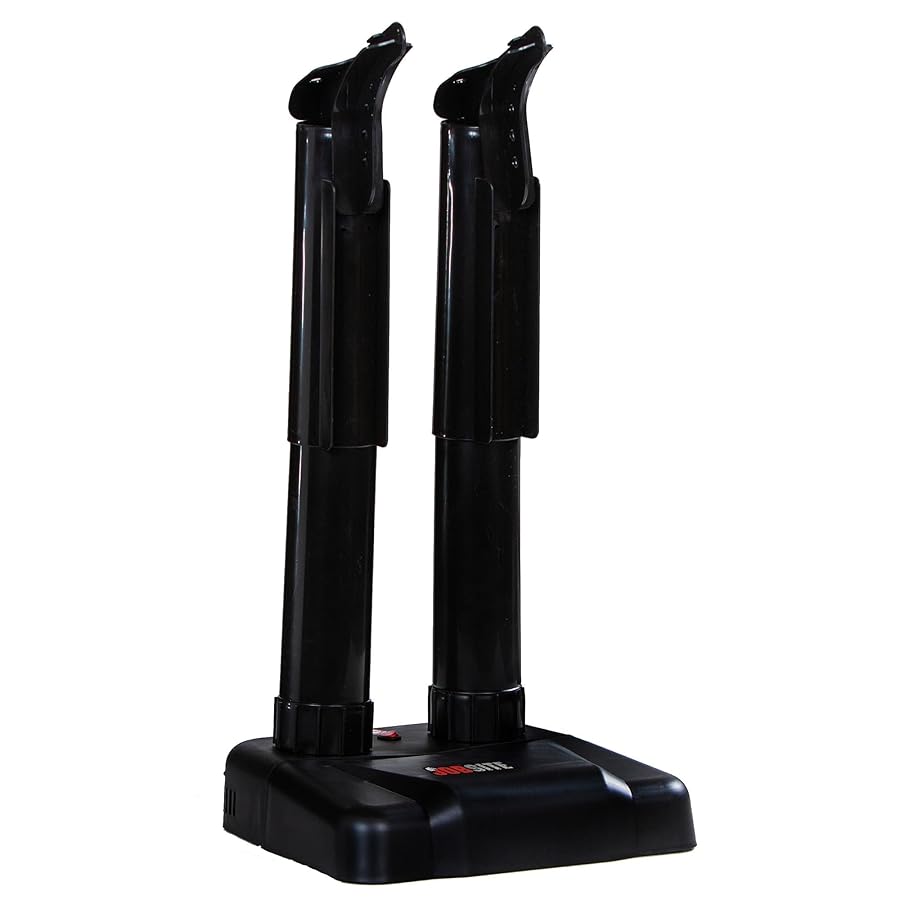
Key Features to Consider
When choosing a boot dryer, several key features ensure effective performance and convenience. Evaluate these features to pick the best dryer for your needs.
Heating Technology Options
The heating technology determines the speed and safety of the drying process. Different technologies meet different needs:
- Forced-Air Drying: Uses fans to blow warm air into the boots, enabling fast drying.
- Convection Heat: Employs natural airflow and steady heat, providing silent and gradual drying.
- UV Light Integration: Combines drying with bacteria and odor reduction using ultraviolet technology.
- Adjustable Heat Levels: Lets you customize the temperature for sensitive materials like leather or fabric.
Choose a boot dryer with the right heating technology to suit your footwear type.
Timer and Adjustable Settings
Timers and adjustable settings offer better control over the drying process. Key options include:
- Built-in Timer: Enables automatic shutdown after a preset duration, preventing overheating.
- Adjustable Heat Levels: Lets you tailor heat intensity to materials like leather or synthetic fabrics.
- Multiple Drying Modes: Some dryers feature modes for fast drying, gentle drying, or deodorizing.
These settings ensure your boots are safely and effectively dried.
Noise Level and Energy Efficiency
Noise level and power consumption impact convenience and cost. Consider these aspects:
- Low-Noise Models: Ideal for use in homes or shared spaces without disturbing others.
- Energy-Saving Features: Includes lower wattage or eco modes to reduce electricity usage.
- Portable Battery Options: Some models operate on batteries, perfect for travel or outdoor use.
Energy-efficient and quiet boot dryers are great for long-term satisfaction.
Selecting a boot dryer with these features ensures your boots dry safely, efficiently, and quietly.
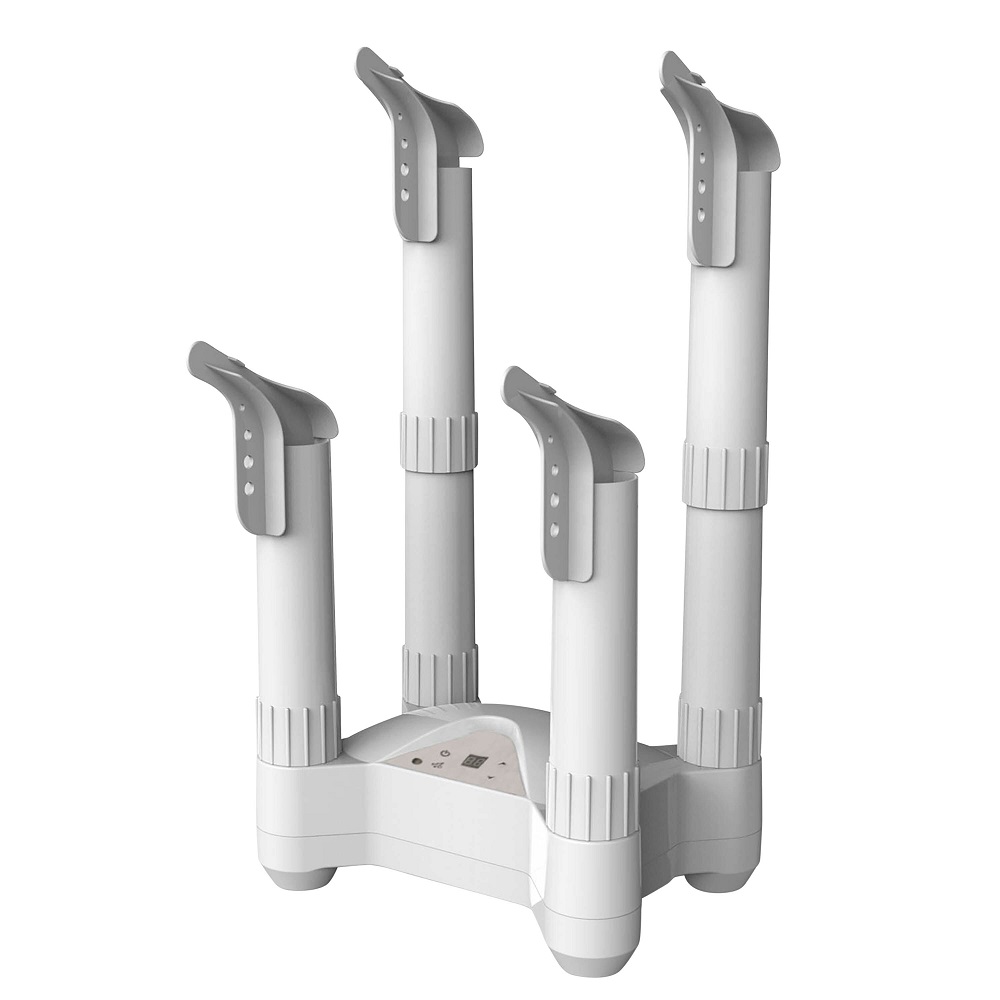
Best Dryers for Specific Needs
Choosing the right boot dryer is essential for meeting your specific requirements. Explore the best options tailored for outdoor activities, compact storage solutions, and quick drying needs.
Boot Dryers for Outdoor Enthusiasts
Outdoor enthusiasts face challenging conditions, often dealing with wet and muddy boots. A suitable dryer offers convenience and durability for active lifestyles.
- Durable Construction: Designed to handle rugged boots used in hiking, camping, or heavy-duty work.
- Portable Models: Perfect for outdoor trips, compact for carrying in backpacks or vehicles.
- Battery-operated or Dual Powered: Allows flexibility for use in remote areas without electricity.
- Fast Drying: Quickly removes moisture to keep boots ready for your next adventure.
Investing in a sturdy, portable boot dryer ensures reliability in tough terrain.
Compact Options for Small Spaces
For those with limited space, compact boot dryers are ideal. These models provide effective drying without taking up much room.
- Slim Designs: Perfect for small apartments or storage areas.
- Wall-mounted Models: Save floor space and offer easy installation.
- Quiet Operation: Great for home use without disturbing the household.
- Ease of Storage: Foldable or lightweight designs for simple packing and storing.
Compact boot dryers fit seamlessly into tight spaces while delivering reliable performance.
High-Speed Dryers for Quick Results
When time is limited, high-speed boot dryers are a lifesaver. They deliver dry boots swiftly to keep you moving.
- Forced-Air Technology: Utilizes powerful fans for rapid moisture removal.
- Timer Settings: Lets you control drying duration efficiently for your schedule.
- Multiple Ports: Simultaneously dries multiple pairs of boots to save time.
- Efficient Energy Use: High performance without excessive electricity consumption.
High-speed models are perfect for busy individuals or families needing fast drying solutions.
Selecting the best boot dryer depends on your activities and space. Choose a model tailored to your lifestyle for maximum convenience.
Maintenance and Care of Boot Dryers
Proper maintenance ensures your boot dryer lasts longer and performs efficiently. Regular care can prevent issues and improve reliability. Follow these tips to keep your dryer in excellent condition.
Cleaning Tips for Long-lasting Performance
Keeping your boot dryer clean is essential to maintain its functionality. Here are some effective cleaning tips:
- Unplug Before Cleaning: Always disconnect the dryer from power before cleaning it.
- Wipe Exterior Surfaces: Use a damp cloth to remove dust, dirt, and grime from the outer shell.
- Clean Air Vents: Check and clean air vents regularly to ensure proper airflow.
- Inspect Heating Elements: Gently wipe heating components with a soft cloth to remove debris.
- Avoid Harsh Chemicals: Use mild soap and water for cleaning; harsh cleaners can damage surfaces.
- Dry Completely: Ensure all parts are completely dry before plugging it back in.
By cleaning your boot dryer frequently, you can avoid buildup that could compromise its performance.
Troubleshooting Common Issues
Boot dryers may occasionally face problems. Here’s how to address common issues:
- Dryer Not Turning On:
- Ensure it is plugged into a functional power outlet.
- Check if the fuse or circuit breaker has tripped.
- Uneven Drying:
- Clean the vents to restore proper airflow.
- Verify that boots are placed correctly for even drying.
- Strange Odors:
- Clean the dryer thoroughly, especially if dealing with odor-causing bacteria.
- Consider replacing any built-in deodorizing elements if applicable.
- Overheating:
- Inspect fans for blockages that might restrict airflow.
- Avoid running the dryer beyond its recommended time limit.
- Unusual Noises:
- Tighten loose screws or check for debris stuck in the fan components.
- If noise persists, contact the manufacturer for assistance.
Addressing these issues quickly ensures your boot dryer remains reliable and effective. A well-maintained dryer keeps your boots dry and ready for any activity.
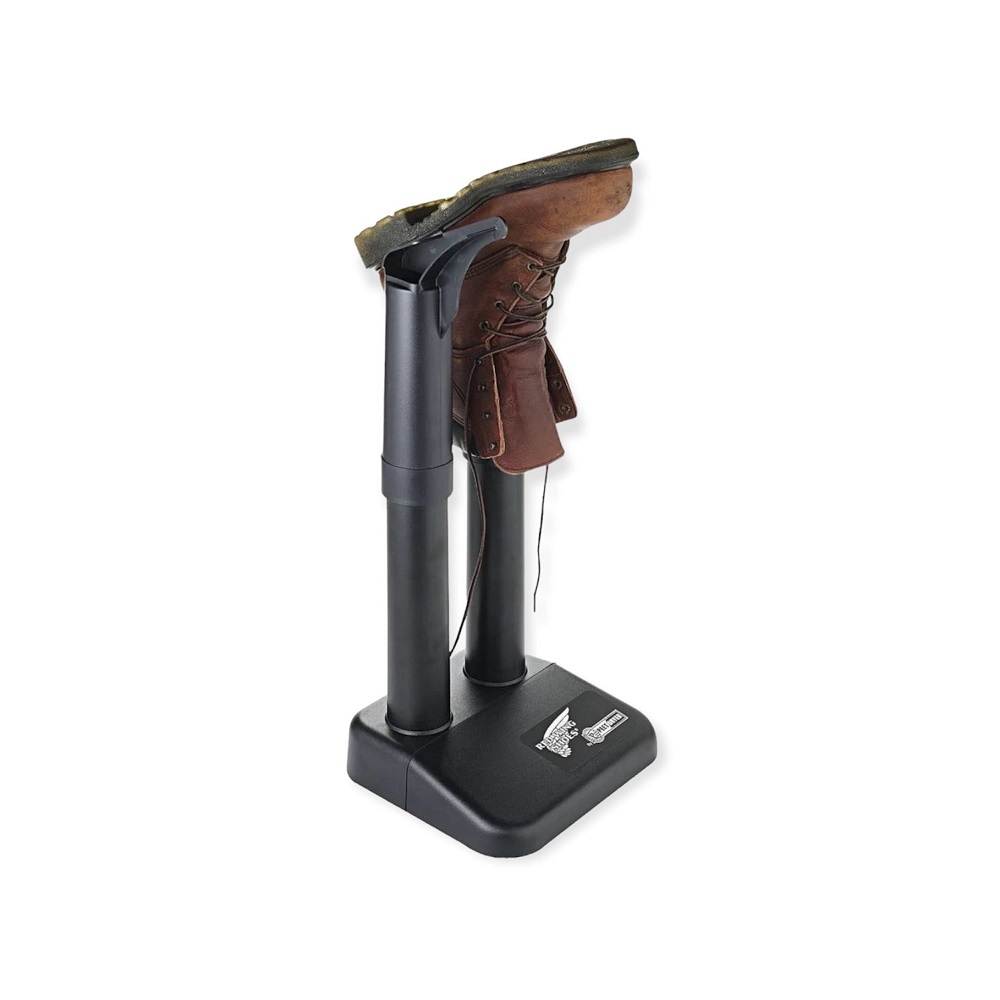
Budget vs. Premium Boot Dryers
Choosing between budget and premium boot dryers depends on your needs and budget. Both options have their advantages. Let’s explore their differences to help you decide.
Cost Comparison
- Budget Boot Dryers:
- Price range: $20 to $50.
- Affordable and simple in design.
- Ideal for occasional use or light-duty drying.
- Usually non-electric or basic electric models.
- Premium Boot Dryers:
- Price range: $100 to $200 or more.
- High-performance models with advanced features.
- Durable and designed for daily or heavy-duty use.
- Often includes forced-air drying, UV light, and timers.
Budget boot dryers save money upfront. Premium options offer superior features but cost more.
Features to Expect at Different Price Points
- Features in Budget Models:
- Basic convection or non-electric drying.
- Compact and lightweight designs.
- Limited or no adjustable settings.
- Suitable for casual users and mild climates.
- Features in Premium Models:
- Advanced drying technologies like forced-air or UV integration.
- Customizable heat levels and multiple drying modes.
- High-speed drying for quick results.
- Durable build and support for heavy, rugged boots.
- Extra functions like quiet operation and energy efficiency.
Budget models are perfect for basic needs. Premium models add convenience and enhanced performance.
When choosing, weigh your requirements against the price. A budget model works for minimal needs. Premium dryers are worth it for frequent or demanding use.
Frequently Asked Questions
Boot dryers are useful, but you might have some questions. Here are answers to commonly asked queries.
Are Boot Dryers Safe for Different Materials?
Yes, boot dryers are generally safe for various materials. However, check the dryer settings for compatibility with your boots. Here are some points to consider:
- Leather Boots: Use low or adjustable heat settings to prevent cracking or damage.
- Fabric Boots: Opt for models with gentle air circulation to avoid material warping.
- Synthetic Materials: Ensure the temperature is suitable to prevent softening or melting.
- Waterproofing Layers: High heat can affect waterproof linings in some boots. Use moderate warmth for safety.
Always consult the manufacturer’s guidelines for your footwear. This ensures the dryer doesn’t harm the material.
How Long Does it Take to Dry Boots?
The drying time for boots depends on the dryer’s technology and the moisture level. Below are some typical durations:
- Forced-Air Dryers: Usually dry boots within 1–3 hours, making them ideal for quick drying.
- Convection Models: Require 3–6 hours, depending on the humidity and boot material.
- Non-Electric Dryers: May take 8–24 hours, relying entirely on natural airflow or desiccants.
Thicker boots, like winter or heavy-duty work boots, might take longer. Adjust time based on wetness. Timers in high-end dryers help prevent drying for too long.
Knowing these timelines ensures you choose the right boot dryer for your needs.
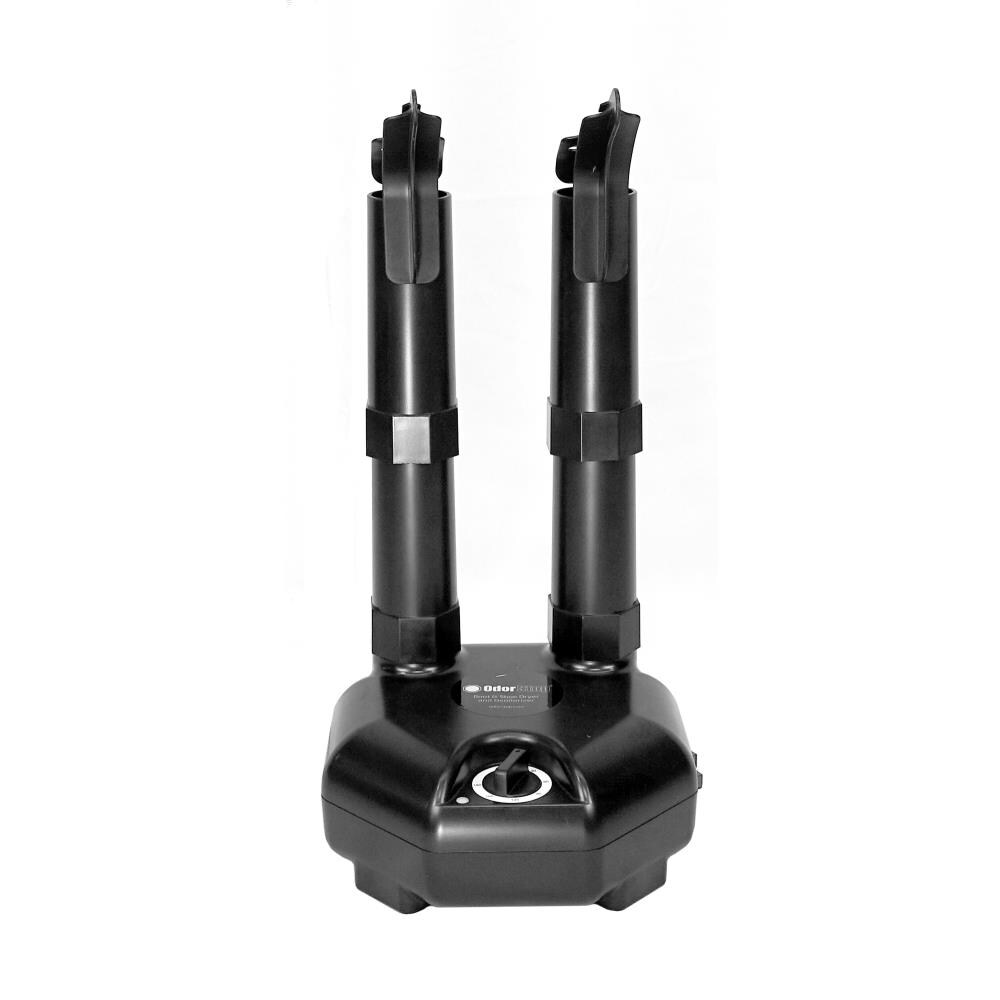
The Environmental Considerations
Energy Consumption
When choosing a boot dryer, consider its energy consumption. Many electric models can operate for extended periods, leading to higher electricity use. Opt for energy-efficient models that consume less power while effectively drying your footwear.
Different brands also offer varying wattage options. Lower wattage models may take longer to dry but use less energy. Finding a balance between efficiency and energy savings will aid in lowering your environmental footprint.
Sustainable Materials
In recent years, more manufacturers are using sustainable materials in their products. When selecting a boot dryer, consider brands that prioritize eco-friendly materials and production methods. Choosing an environmentally conscious machine contributes positively to the sustainability movement and promotes responsible consumption.
Support brands that incorporate recycling practices or use biodegradable components. This not only benefits the environment but also encourages more companies to adopt sustainable practices. Being a conscious consumer can lead to significant collective impact.
Maintenance for Longevity
Proper maintenance of your boot dryer contributes to its longevity and effectiveness. Regularly clean the air passages and vents to prevent lint buildup. Following the manufacturer’s maintenance recommendations is essential for keeping the dryer in good working condition.
A well-maintained dryer performs more efficiently, saving energy and extending its lifecycle. Take note of any wear and tear to address minor issues before they lead to larger problems. This proactive approach helps ensure that your appliance serves you reliably over the years.
Conclusion
In summary, selecting the right boot dryer and using it effectively is essential for maintaining your footwear in optimal condition. Understanding the importance of drying your boots properly enhances their longevity and performance. Various dryer options are available, including electric, forced air, and manual models, each serving unique needs.
By taking the time to choose the right type of dryer, you can set your boots up for success, regardless of the conditions they face. Proper care, including cleaning, maintenance, and energy considerations, further enhances the overall experience of using a boot dryer.
With the knowledge gained from this guide, you will feel empowered to make informed decisions regarding your boot-drying needs. Embrace the convenience and efficiency of your boot dryer, and enjoy the benefits of fresh, dry footwear ready for your next adventure!

